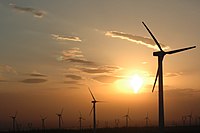
Photo from wikipedia
China’s energy transition, from a coal-dominated system to one with the world largest deployment of wind power, is facing major challenge as China entered the economic “New Normal” in recent… Click to show full abstract
China’s energy transition, from a coal-dominated system to one with the world largest deployment of wind power, is facing major challenge as China entered the economic “New Normal” in recent years. A key phenomenon is serious wind curtailment, where potential clean wind power is abandoned and the associated environmental and climate benefits could not be fulfilled. Multiple causes have been identified to explain the serious wind curtailment in China; but few studies provide explanations for the patterns of wind curtailment and quantify the relative contributions of the underlying factors. We develop a flexible analytical framework and adapted the logarithmic mean Divisia index method to quantify the contributions of key factors in the change of wind curtailment rate. While the early stage of wind curtailment was constrained by limited transmission capacity, recent wind curtailment is primarily driven by the deceleration of the overall economic growth, which resulted in a slowdown of electricity demand and low willingness-to-accept imported power across provinces. The current economic transition has induced an oversupply of power in general and wind power in particular, especially in wind rich provinces. This seems to be hindering further energy transition. With greater political will and better policy design, the oversupply of power could be an opportunity to speed up substitution of coal with wind and to expedite the de-carbonization of the economy.
Journal Title: Applied Energy
Year Published: 2018
Link to full text (if available)
Share on Social Media: Sign Up to like & get
recommendations!